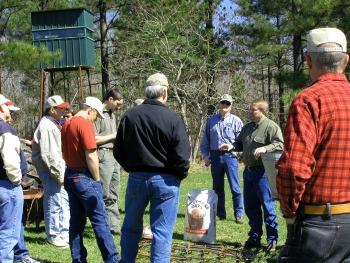Wildlife Food Plots

THE KEY TO SUCCESSFUL FOOD PLOTS is in the soil.
Fertilizing and liming is worth every cent invested. Food plot demonstrations conducted by county Extension agents show that wildlife consume more vegetation grown in plots where soil amendments have been added than plots receiving no soil amendments. Similarly, commercial seed products recommend following a soil test to enhance plant growth. Even if seed doesn't germinate, wildlife will be attracted to fertilized and limed plots. It just makes sense. Take an annual soil test to keep your plot on track. Sometimes soil amendments stay in the ground for several years, so reapplication may not be necessary.
For more information about food plots, free soil testing, and unbiased assistance with interpreting soil test results, contact your local county Extension office.
The Bigger Picture - Why habitat management plans work
Although wildlife food plots attract deer, wild turkeys, bobwhites, doves, and waterfowl to a particular location for hunting or viewing purposes, wildlife professionals encourage landowners to consider implementing additional habitat practices besides relying on food plots.
- A well-designed habitat management plan which includes practices such as prescribed burning or thinning trees will improve habitat quality for a variety of wildlife species.
- Typically these alternative practices cost less per acre than food plots.
- Contact a private lands biologist with the Arkansas Game and Fish Commission (800-364-4263) about preparing a plan for your property.
Those who lease land may be restricted from using habitat practices, in particular hunting clubs leasing industrial forest lands. Planting grasses and forbs in food plots provides patches of diverse habitat. By cultivating and seeding in strategic locations, viewing and hunting opportunities are improved. Hunters can draw wildlife into openings for selective harvest as one component of a deer management plan. Others plant food plots or native grasses near homes or cabins to enjoy seeing songbirds and butterflies, or hear a whistling bobwhite.
Following are resources for meeting your goals to attract wildlife and improve habitat on small plots of property.
Extension Resources
-
- Establishing Wildlife Food Plots
- Electric Fence Design for Deterring White-tailed Deer (while establishing food plots, for example) PDF Video
Soil and seed planting preparation
-
Wildlife plantings
- Grasses and Forbs for Wildlife: Fall and Winter Food Plots
- Grasses and Forbs for Spring and Summer Food Plots
- Annual and Perennial Forage Clovers for Arkansas
- General Traits of Forage Grasses Grown in Arkansas
- Native Warm-Season Grasses for Forage (used mostly for cover by wildlife)
- Sunflowers Grown for Dove Hunting
-
Controlling invasive plants
-
Rules and regulations - hunting migratory species over planted vs. native vegetation
-
Species Management
Other Resources |
|